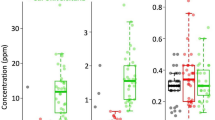Abstract
Excrement cast from Great Blue Heron nests was collected during the nesting period of 1978 from four colonies in Washington and Idaho. Cheesecloth strips placed on the ground beneath the nests served as excrement collecting devices. Chemical analysis for lead, mercury and cadmium were performed on dried samples. Lead was the most abundant trace metal found in heron debris. The Idaho colony at Lake Chatcolet had an average concentration of 46 ppm in the beneath-nest samples and 6 ppm in control samples. A heron colony near Tacoma, Washington had beneath-nest samples averaging 28 ppm and control samples averaging 20 ppm. Two colonies located in the interior region of Washington had substantially lower concentrations of lead. The difference observed between colonies was attributed to their associations with a polluted watershed (Chatcolet colony) an interstate highway (Tacoma colony) and an unpopulated largely agricultural area (inland Washington).
Similar content being viewed by others
References
American Ornithologists' Union: 1957, Check-list of North American Birds, 5th ed. Amer. Ornithol. Union, Baltimore.
Bent, A. C.: 1926, Life Histories of North American Marsh Birds, U.S. Natl. Mus. Bull. 135.
Custer, T. W. and Osborn, R. G.: 1977, Wading Birds as Biological Indicators: 1975 Colony Survey, U.S. Dept. of Interior. Fish and Wild. Serv. Special Scientific Report No. 206, 28 pp.
Custer, T. W. and Osborn, R. G.: 1978, ‘Feeding Habitat Use by Colonially - Breeding Herons, Egrets, and Ibises in North Carolina’, The Auk 95, 733–743.
English, S. M.: 1978, ‘Distribution and Ecology of Great Blue Heron Colonies on the Willamette River, Oregon’, in A. Sprunt IV, J. C. Ogden, and S. Winckler (eds.), Wading Birds, National Aubudon Society, New York, New York, pp. 235–255.
Kushlan, J. A.: 1978, ‘Feeding Ecology of Wading Birds’, in A. Sprunt IV, J. C. Ogden, and S. Winckler (eds.), Wading Birds, National Audubon Society, New York, New York, pp. 249–297.
Palmer, R. S. (ed.): 1962, Handbook of North American Birds, Vol. I, Yale University Press, New Haven, Connecticut.
Rabe, F. W. and Bauer, S. B.: 1977, ‘Heavy Metals on Lakes of the Couer d'Alene River Valley, Idaho’, Northwest Sci. 51, 183–197.
Rickard, W. H., Hedlund, J. D., and Schreckhise, R. G.: 1978, ‘Rejecta Cast from Heron Nests as an Indicator of Food Chain Contamination’, The Auk 95, 425–427.
Vermeer, K.: 1973, ‘Great Blue Heron and Double-crested Cormorant Colonies in the Prairie Provinces’, The Canadian Field Naturalist 87, 427–432.
Werschkul, D., McMahon, E., Leitzchuk, M., English, M., Skibinski, C., and Williamson, G.: 1977, ‘Observations on the Reproductive Ecology of the Great Blue Heron (Ardea herodias) in Western Oregon’, The Murrelet 58, 7–12.
Wiese, J. H.: 1978, ‘Heron Nest-site Selection and Its Ecological Effects’, in A. Sprunt IV, J. C. Ogden, and S. Winckler (eds.), Wading Birds, National Audubon Society, New York, New York, pp. 27–34.
Author information
Authors and Affiliations
Rights and permissions
About this article
Cite this article
Fitzner, R.E., Rickard, W.H. & Hinds, W.T. Excrement from Heron colonies for environmental assessment of toxic elements. Environ Monit Assess 1, 383–386 (1982). https://doi.org/10.1007/BF00403838
Received:
Issue Date:
DOI: https://doi.org/10.1007/BF00403838




